
ismagilov
All sorrows are less with bread . ― Miguel de Cervantes Saavedra.
Today, we take a deeper look at a financial name that seems very cheap on the surface despite the current turmoil in some parts of the financial system. The shares also have some buying from a beneficial owner recently. An analysis follows below.
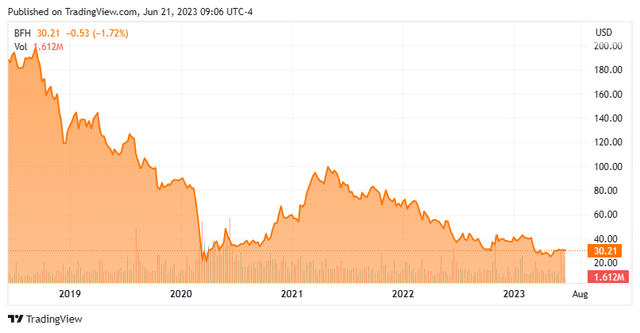
Seeking Alpha
Company Overview:
Bread Financial Holdings, Inc. ( NYSE: BFH ) is a Columbus, Ohio, based financial services concern, providing payment, lending, and savings solutions to consumers, primarily through its ~100 credit card partners, including Ulta Beauty ( ULTA ) and Victoria’s Secret ( VSCO ). The company also offers direct-to-consumer solutions through its branded Bread Cashback American Express ( AXP ) credit card and savings products. Bread was formed through a merger of The Limited’s credit card bank operation and J.C. Penny’s transaction services business in 1996. It went public as Alliance Data Systems in 2001, raising net proceeds of $160.8 million at $12 a share. After peaking at $249.00 a share in 2015, Bread currently trades just over $30.00 a share, translating to an approximate market cap of just over $1.5 billion.
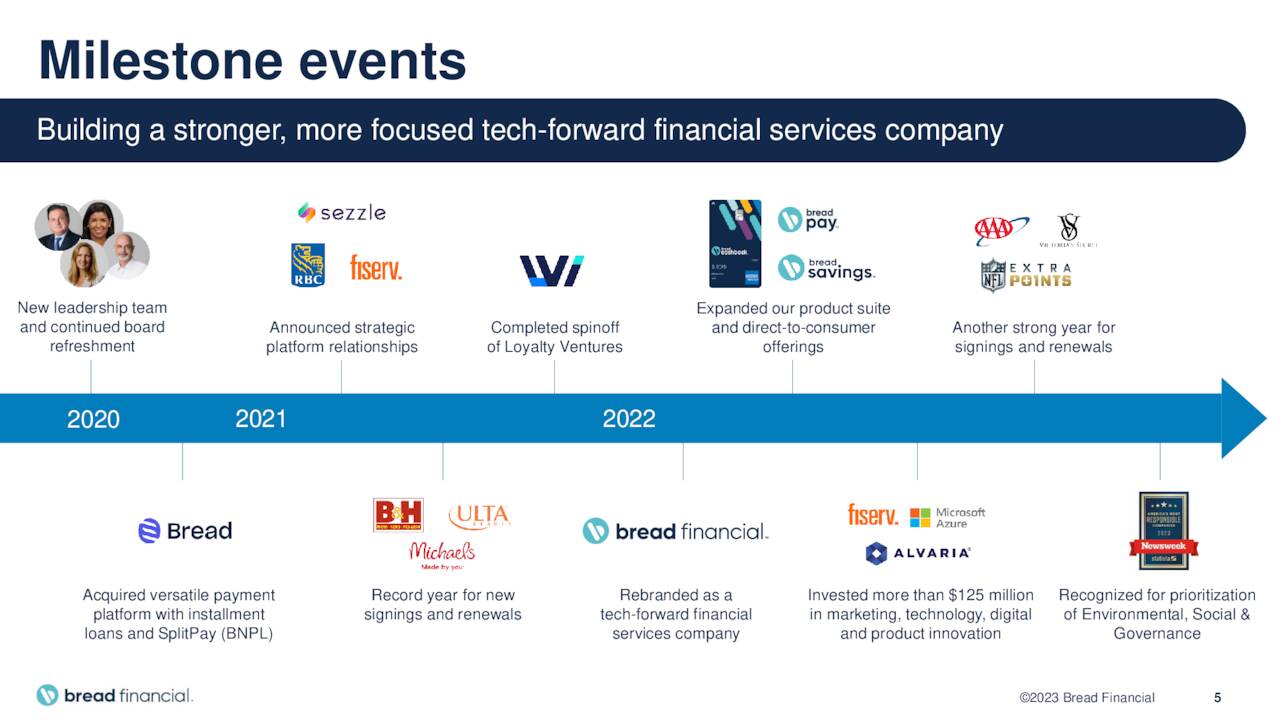
February Company Presentation
The company’s funding mix at YE22 was comprised of wholesale deposits (39%), retail deposits (26%), secured borrowings (25%), and unsecured borrowings (10%). Over 90% of the retail deposits are FDIC insured. Co-branded and proprietary credit cards (as opposed to private label cards) account for approximately half of Bread’s credit sales.
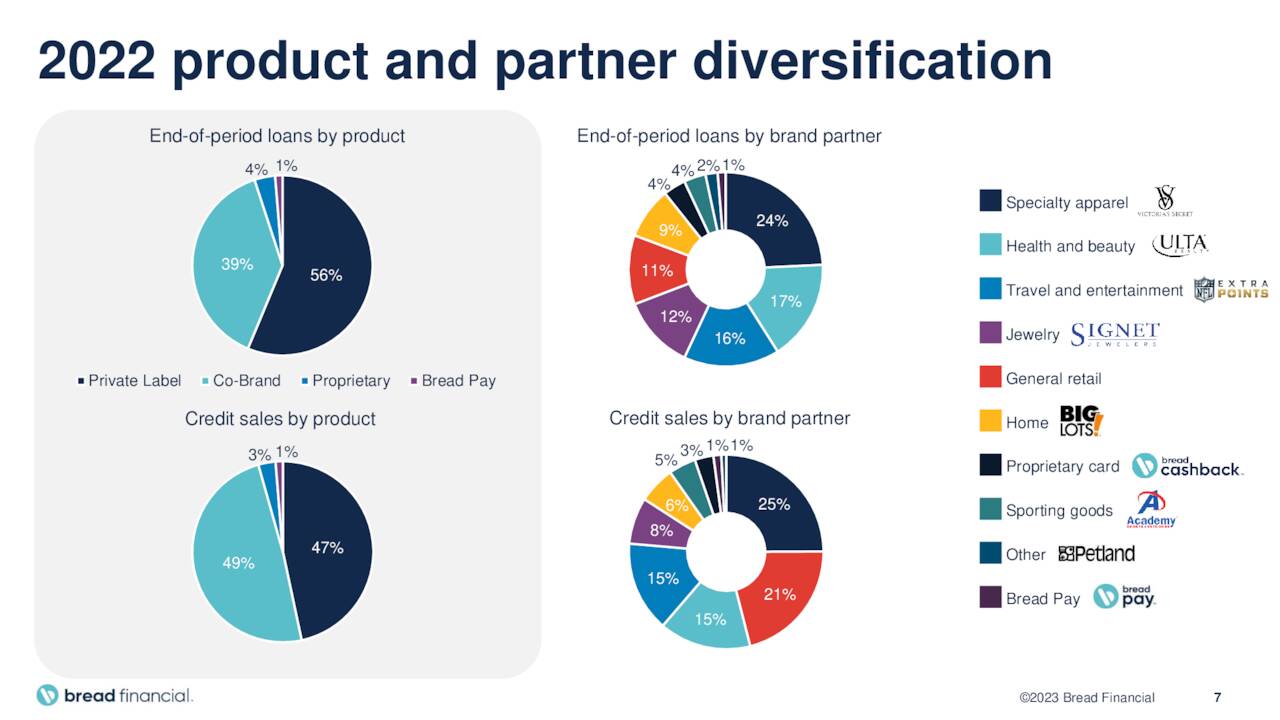
February Company Presentation
Transformation
Beginning in 2018, Alliance began a transformation that resulted in the divestment of its Epsilon marketing and data services operation in 2019, the spinoff of its low-margin LoyaltyOne marketing segment in 2021, and the transition of its credit card processing services unit in 2022. In 2020, Alliance acquired Bread’s omnichannel technology platform integrating retailers and bank partners with the goal of offering installment and buy now, pay later (“BNPL”) loans at point-of-sale. For $450 million, Alliance not only advanced towards its objective of becoming a tech-forward financial services provider, but also acquired its new moniker, which it formally rebranded to in March 2022.
Share Price Performance
After earning (at that time) $14.10 a share (GAAP) in FY17 and on its way to $17.49 a share (GAAP) in FY18, management announced that it had completed a review of its portfolio of businesses in October 2018, concluding that its stock price did not reflect the value of said portfolio. That announcement actuated the aforementioned transformation and marked a high watermark for Bread’s stock ($164.27 a share). Already down by about half entering 2020, shares of BFH cratered to $16.37 during the pandemic selloff as the market expected (and received) a significant drop in retail activity during FY20.
To right the ship, a new management team was onboarded that year. As the economy reopened with consumers flush with pandemic aid while interest rates (i.e., Bread’s funding costs) remained muted during FY21, the credit card concern rallied back to a post-pandemic intraday high of $102.28 in June of that year. Curiously, net interest income was essentially flat FY21 vs. FY20, but owing to the Goldilocks scenario, loan loss provisions dropped $722 million to $544 million, allowing Bread to earn $15.95 a share (GAAP) in FY21.
With the return of high energy price driven inflation and consequent Fed tightening, shares of BFH began their slide, further exacerbated by the run on Silicon Valley Bank ( OTCPK:SIVBQ ) in early 2023.
FY22 Results
That said, Bread’s FY22 was not bad, especially relative to its initial projections. Despite the challenging macroeconomic environment, Bread generated pretax, pre-provision earnings (PPNR) of $1.89 billion on net interest income of $4.18 billion versus PPNR of $1.59 billion on net interest income of $3.49 billion in FY21. Net interest margin increased 100 basis points to 19.2%. Average loans outstanding rose 13% to $17.77 billion, while its net loss rate grew from 4.6% to 5.4%. Retail deposits on its Bread Savings platform spiked 72% to $5.47 billion. Overall, total deposits grew 25% to $13.8 billion. All these outcomes were in line with management’s outlook at the onset of FY22.
Negatives included the announcement (at the onset of FY22) that it had lost BJ’s Wholesale Club ( BJ ) business (effective FY23), which accounted for 10% of its net interest income in FY22; and the value of its former LoyaltyOne business, of which Bread still owned close to 20%, had cratered – eventually filing for bankruptcy in March 2023.
Bread did increase its credit loss absorption capacity through increasing loan loss reserves by $1.05 billion to $1.59 billion. That move significantly impacted GAAP earnings, which fell from $16.02 a share in FY21 to $4.46 a share in FY22. But with PPNR improving 19%, FY22 could rightly be characterized as a success.
The market ” rewarded” this performance by selling its stock off 42% over calendar 2022.
FY23 Outlook
After management hit on all its predictions in FY22, it offered its outlook for FY23 in February 2023. In line with its more challenging economic outlook that includes higher unemployment, Bread expected mid-single digit loan growth, which included the anticipated sale of its BJ Wholesale loan portfolio. Net interest income was projected to be in line with that growth as net interest margin was expected to be flat at 19.2%. Net loss rate was expected to rise from 5.4% to ~7.0%. As a matter of perspective, the net loss rate peaked at 10.0% during the 2008-2009 banking crisis. Given that Bread can deliver on its internal predictions, it can be argued that its stock is significantly undervalued.
1QFY23 Results
The first step towards delivering on its forecast came on April 27, 2023, when the financial services concern delivered Q1 earnings of $9.08 a share (GAAP) on revenue of $1.28 billion, besting the Street consensus by $1.63 a share and $220 million. Total net interest income rose 13% year-over-year to $1.12 billion, as average loan balance increased 17% to $19.4 billion while net interest margin fell 40 basis points to 19.0%. PPNR improved 50% year-over-year to $745 million, although that improvement was almost entirely a function of two items: a $230 million pretax gain on the sale of BJ’s Wholesale portfolio and seasonal paydowns. On an apples-to-apples basis, it was up 4% year-over-year.
Management did not change its FY23 outlook.
Balance Sheet & Analyst Commentary:
With hundreds of billions of deposits exiting the banking system since the Fed began its tightening campaign, it was encouraging to see Bread realize a 3% sequential increase in direct-to-consumer deposits to $5.6 billion (1Q23 vs 4Q22), which also represented a 70% increase year-over-year. That said, Bread’s total deposits fell $700 million sequentially to $13.1 billion and its overall cost of deposits increased sequentially from 3.1% in 4Q22 to 3.5% in 1Q23.
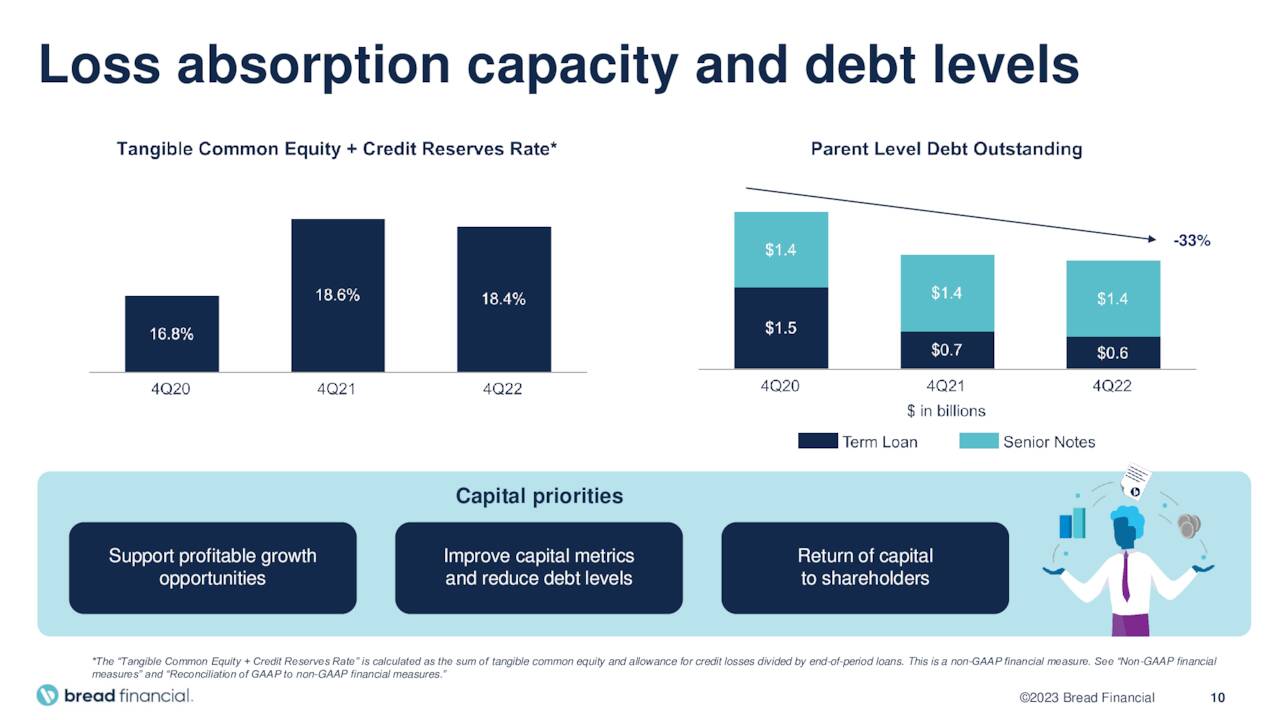
February Company Presentation
The Bread balance sheet is in solid shape, with the credit card concern holding cash of $3.6 billion against long-term debt of $1.9 billion. Debt has dropped 39% since 1Q20 – when the new management team arrived. Capital ratios are in excellent shape with its CET1 ratio at 20.2% and tangible common equity / tangible assets at 9.1%. Allowance for credit losses reserves were $2.22 billion, or 12.3% (up from 11.5% in 4Q22, simply to adjust for the loss of BJ’s higher quality portfolio). In theory, these conservative metrics would give management the flexibility to increase the dividend, which at its current $0.21 per quarter, provides a yield of 2.8%. Further buttressing management’s performance, Bread’s tangible book value increased at a CAGR of 36%, from $15.41 a share in 1Q20 to $38.44 a share in 1Q23.
Despite its solid performance in FY22 and good start to FY23, Street analysts are somewhat spooked by falling M2; thus, featuring five buy/outperform ratings and six holds. In late April, Keefe Bruyette lowered its rating on Bread from outperform to hold and its price target from $35 to $30, citing the macroeconomic backdrop. Bank of America did reissue its Buy rating and $43 price target of the stock last week. On average, they expect Bread to earn $11.76 a share (non-GAAP) on revenue of just under $4.3 billion in FY23, followed by $9.85 a share on similar sales in FY24.
Beneficial owner Turtle Creek Asset Management has used the depressed levels as an opportunity to cost average its position in Bread, purchasing 447,618 shares in early May between $23.50 and $27.00 a share.
Verdict:
It’s challenging to catch a falling knife in an environment where inflation is eating into consumer discretionary spending and a slowing economy (courtesy of Fed tightening) is deteriorating credit quality. And the loss of BJ’s higher-credit quality portfolio will not help the quality of its credit risk.
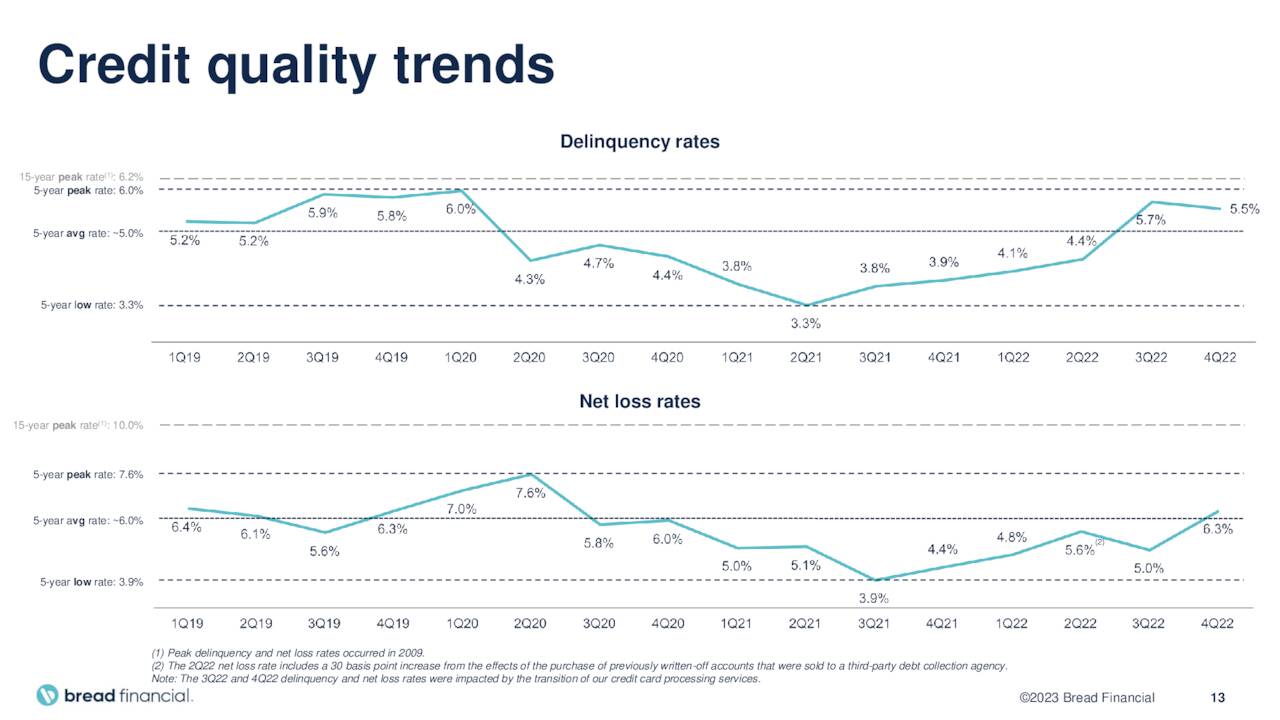
February Company Presentation
That said, with a strong balance sheet and over 90% of its direct-to-consumer deposits FDIC-insured, Bread is poised to weather the storm. Trading at around thirty bucks a share with a tangible book value of $38.44 a share, it is expected to earn $21.61 a share over the next two years. I think those estimates are likely to come down significantly as I see the country heading into a recession.
That said, Bread Financial Holdings, Inc. stock seems cheap enough to merit a ” watch item” holding for now, and I recently added a small position via covered call orders to my own portfolio.
.. . Carb-e Diem. Seize the bread .”― Ryan La Sala, Be Dazzled.

